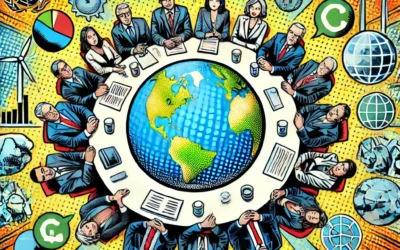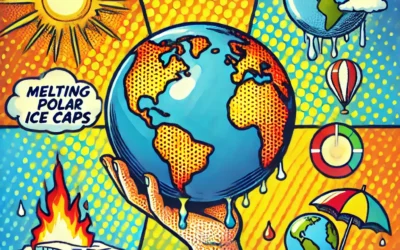The Scope of Environmental Problems
The term “environmental problems” encompasses a wide range of issues that negatively impact the natural world and human societies. These problems are interconnected, meaning that addressing one often involves tackling others as well. Understanding the scope of these problems is crucial for developing effective strategies to combat them.
1. Climate Change
Climate change is one of the most urgent environmental problems facing the world today. Driven primarily by the increase in greenhouse gas emissions from human activities, such as burning fossil fuels and deforestation, climate change leads to rising global temperatures, melting polar ice, and more frequent and severe weather events. The effects of climate change are widespread, affecting ecosystems, economies, and communities around the world.
2. Air Pollution
Air pollution is another significant environmental problem that affects millions of people globally. It is caused by the release of harmful substances into the atmosphere, such as carbon monoxide, sulfur dioxide, nitrogen oxides, and particulate matter. These pollutants come from various sources, including vehicles, industrial processes, and the burning of fossil fuels. Air pollution contributes to respiratory and cardiovascular diseases, reduces life expectancy, and damages ecosystems.
3. Water Pollution
Water pollution is a critical environmental problem that affects rivers, lakes, oceans, and groundwater. It occurs when harmful substances, such as chemicals, plastics, and waste, are discharged into water bodies. These pollutants can come from industrial discharges, agricultural runoff, untreated sewage, and oil spills. Water pollution threatens aquatic life, contaminates drinking water supplies, and disrupts the balance of ecosystems.
4. Deforestation
Deforestation, the large-scale clearing of forests, is a major environmental problem that contributes to climate change, loss of biodiversity, and soil degradation. Forests play a vital role in regulating the Earth’s climate by absorbing carbon dioxide and producing oxygen. The destruction of forests, often driven by agriculture, logging, and urbanization, releases stored carbon into the atmosphere and reduces the planet’s capacity to sequester carbon.
5. Loss of Biodiversity
The loss of biodiversity is one of the most concerning environmental problems of our time. Biodiversity, which refers to the variety of life on Earth, is essential for maintaining healthy ecosystems and providing services such as pollination, water purification, and disease regulation. Human activities, such as habitat destruction, pollution, overexploitation, and climate change, are driving species to extinction at an unprecedented rate.
6. Soil Degradation
Soil degradation is another environmental problem that has far-reaching implications for food security and ecosystem health. It occurs when the quality of soil declines due to factors such as deforestation, overgrazing, industrial agriculture, and urbanization. Degraded soils lose their ability to support plant life, retain water, and store carbon, leading to reduced agricultural productivity and increased vulnerability to climate change.
Causes of Environmental Problems
The root causes of environmental problems are often linked to human activities that exploit natural resources, produce waste, and alter ecosystems. Understanding these causes is essential for developing solutions that address the underlying issues.
1. Overconsumption of Resources
The overconsumption of natural resources is a major driver of environmental problems. The demand for energy, water, food, and raw materials has led to the depletion of forests, fisheries, freshwater resources, and minerals. This overconsumption is often fueled by population growth, economic development, and consumer culture.
2. Pollution from Industrial and Agricultural Activities
Industrial and agricultural activities are significant sources of pollution, contributing to air, water, and soil contamination. Factories and power plants release pollutants into the atmosphere, while agricultural practices, such as the use of pesticides and fertilizers, contribute to water pollution and soil degradation.
3. Urbanization and Land Use Change
Urbanization and land use change are also major contributors to environmental problems. The expansion of cities and infrastructure leads to the destruction of natural habitats, increased pollution, and higher demand for resources. Land use change, such as converting forests to agricultural land, also contributes to deforestation and biodiversity loss.
4. Climate Change
Climate change itself is both a cause and a consequence of environmental problems. The warming of the planet exacerbates issues such as sea-level rise, extreme weather events, and changes in ecosystems. These changes, in turn, contribute to the degradation of natural resources and the loss of biodiversity.
Solutions to Environmental Problems
Addressing environmental problems requires a multifaceted approach that involves governments, businesses, and individuals. Solutions must be tailored to the specific issues at hand and involve both mitigation and adaptation strategies.
1. Transitioning to Renewable Energy
One of the most effective solutions to environmental problems, particularly climate change, is transitioning from fossil fuels to renewable energy sources, such as solar, wind, and hydropower. Renewable energy generates electricity with little to no greenhouse gas emissions, reducing the impact on the climate and improving air quality.
2. Sustainable Agriculture and Land Management
Adopting sustainable agriculture practices and better land management can help address several environmental problems, including deforestation, soil degradation, and water pollution. Techniques such as agroforestry, conservation tillage, and integrated pest management can increase agricultural productivity while preserving natural resources and protecting biodiversity.
3. Pollution Control and Waste Management
Implementing pollution control measures and improving waste management systems are crucial for reducing the impact of industrial and agricultural activities on the environment. This includes regulating emissions, promoting recycling and composting, and developing technologies to treat and reduce waste.
4. Conservation and Restoration of Ecosystems
Conservation and restoration efforts are vital for protecting biodiversity and maintaining the health of ecosystems. Establishing protected areas, restoring degraded habitats, and reintroducing endangered species can help preserve the planet’s natural heritage and ensure the continued provision of ecosystem services.
5. Education and Awareness
Raising awareness and educating the public about environmental problems and their solutions is essential for fostering a culture of sustainability. Environmental education can empower individuals to make informed decisions, reduce their ecological footprint, and advocate for policies that protect the environment.
Conclusion
Environmental problems present some of the most significant challenges of our time, but they also offer opportunities for innovation and positive change. By understanding the causes and impacts of these problems, we can develop and implement effective solutions that protect the environment, promote sustainability, and improve the quality of life for all. Addressing environmental problems requires collective action from governments, businesses, and individuals, as well as a commitment to creating a sustainable future for generations to come.






